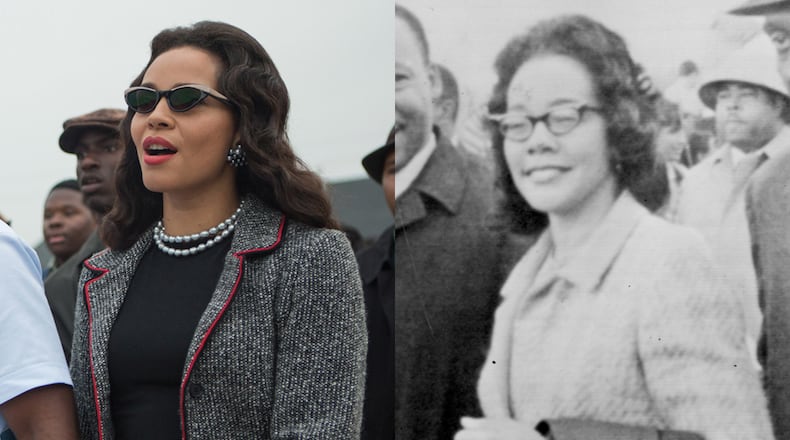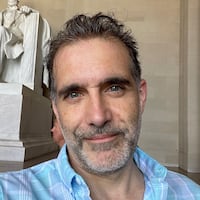Ana DuVernay's film from 2014, shot in an around Atlanta, took pains to visually recreate the look and feel of the events made famous in 1965, right down to the casting and costumes worn by the film's versions of historical figures.
Here's a side-by-side comparison of the actors of "Selma" and their real-life counterparts, as they appeared in 1965.
MARTIN LUTHER KING, JR. (1929-1968): Played by David Oyelowo in 'Selma.' By the time King received his Nobel Peace Prize in 1964 (the first scene of the film), he was already famous for the successful Montgomery Bus Boycott of 1955-56, for his 'Letter from Birmingham Jail' and for his 'I Have a Dream' speech during the March on Washington, both in 1963. He had already co-founded the Southern Christian Leadership Conference in 1957, which had led desegregation efforts in Albany, Ga., Birmingham, and St. Augustine, Fla. After Selma, he became involved in a campaign to improve housing in Chicago, and was an increasingly vocal critic of the Vietnam War. He was still involved in the 'Poor People's Campaign' to address economic disparities, when he was assassinated in Memphis, Tenn. The photo at right is from 1963, the same year as the March on Washington and two years before the Selma marches. (Left photo: Atsushi Nishijima/Paramount Pictures. Right photo: Allyn Baum/The New York Times)
CORETTA SCOTT KING (1927-2006): Played by Carmen Ejogo in 'Selma.' Coretta Scott King often worked alongside her husband during his protest activities and remained an activist for civil rights after MLK's assassination. She founded the Martin Luther King Jr. Center for Nonviolent Social Change, where she served as the president and chief executive officer until 1995. At right, King is marching towards the state capitol in Montgomery during the final leg of the Selma march. (Left photo: Atsushi Nishijima/Paramount Pictures. Right photo: AP file)
JOHN LEWIS (1940-2020): Played by Stephan James in ‘Selma.’ By the time of the Selma marches, Lewis had already participated in the Freedom Rides of 1961 and had spoken at the March on Washington in 1963. He served as chairman of the Student Nonviolent Coordinating Committee from 1963-1966. He went on to become an Atlanta councilman in 1981 and has served in the House of Representatives since 1986. At right, Lewis walks across the Edmund Pettus Bridge during the ‘Bloody Sunday’ march, moments before he was attacked by Selma police. (Left photo: Atsushi Nishijima/Paramount Pictures. Right photo: Birmingham News/Landov Photos)
ANDREW YOUNG (b. 1932): Played by Andre Holland in 'Selma.' Young began working with the Southern Christian Leadership Conference in 1961, leading 'citizenship schools' and coordinating desegregation efforts. He became the SCLC Excutive Director in 1964, and helped draft the Civil Rights Act of 1964 and the Voting Rights Act of 1965. He was elected to the House of Representatives in 1972, then became the U.S. ambassador to the U.N. from 1977-79. He served as mayor of Atlanta from 1982-90. At right, Young is shown marching in Selma. (Left photo: Atsushi Nishijima/Paramount Pictures. Right photo: AJC Archive)
HOSEA WILLIAMS (1926-2000): Played by Wendell Pierce in 'Selma.' An activist since 1952, Williams joined the SCLC in 1964, where he helped conduct voter registration drives. As the film shows, he was the leader of the first Selma march attempt, known as the 'Bloody Sunday' march. In 1971, he founded the Hosea Feed the Hungry and Homeless organization, which continues to this day. He served in the Georgia General Assembly from 1974-84, on the Atlanta City Council from 1985-90, and as a DeKalb County commissioner from 1990-94. The photo at right is from 1966, one year after the marches in Selma. (Left photo: Atsushi Nishijima/Paramount Pictures. Right photo: AP file)
RALPH ABERNATHY (1926-1990): Played by Colman Domingo in 'Selma.' Abernathy began mentoring Martin Luther King, Jr. in 1954, while the two worked in different churches in Montgomery. After helping King lead the city's bus boycott, Abernathy and King joined several others to found the Southern Christian Leadership Conference in 1957, of which Abernathy served as vice president. Abernathy was King's closest aide during the SCLC's operations and the two were arrested together 17 times. After King's assassination, he continued to lead the SCLC's Poor People's Campaign in 1968, which was instrumental in the creation of the Food Stamp Program. At right, Abernathy is marching towards the state capitol in Montgomery during the final leg of the Selma march. (Left photo: Atsushi Nishijima/Paramount Pictures. Right photo: AP file)
C.T. VIVIAN (1924-2020): Played by Corey Reynolds in ‘Selma.’ C.T. Vivian first worked with university students in the 1960 Nashville sit-ins, including John Lewis, Diane Nash and James Bevel. He joined the SCLC in 1961 and participated in the Freedom Rides of that year. He was named the director of SCLC’s affiliates in 1963. Vivian was leading the march in Marion, Ala. where activist Jimmie Lee Jackson was killed, a scene recreated in the film. He has lived in Atlanta since the 1970s and has continued to work with several civil rights organizations. He was awarded a Presidential Medal of Freedom in 2013. At right, Vivian is leading a prayer on the steps of the Selma courthouse in front of Sheriff James Clark. (Left photo: Atsushi Nishijima/Paramount Pictures. Right photo: AP file)
PRESIDENT LYNDON B. JOHNSON (1908-1973): Played by Tom Wilkinson in 'Selma.' Johnson's portrayal in 'Selma' has ignited some controversy. At issue is whether he was a reluctant warrior for civil rights, or a well-placed ally who worked closely with King. Johnson pushed through Congress the Civil Rights Act of 1964 and the Voting Rights Act of 1965, as well as a host of new legislation and government agencies known collectively as the Great Society. One issue that clearly divided King and Johnson was the Vietnam War. With the war driving his approval ratings down, Johnson chose not to seek re-elction in 1968. (Left photo: Atsushi Nishijima/Paramount Pictures. Right photo: Philadelph McAdams/Esselte Corporation)
JAMES BEVEL (1936-2008): Played by Common in 'Selma.' The photo at right is from 1965, several months after the Selma marches. Bevel was involved in the 1960 Nashville sit-in movement with John Lewis, Diane Nash and C.T. Vivian. Bevel became an SCLC director in 1963, and is credited with the Birmingham "Children's Crusade," a controversial tactic that put children on the front lines of the protests. Bevel also had the idea for the children to march to Washington, D.C. Although that never happened, the idea eventually morphed into the more inclusive March on Washington. Bevel and Nash had been working with James Orange in Selma for a year on voting rights when King joined the effort in late 1964, as the film portrays. He is credited with initiating the Selma-to-Montgomery March, the Chicago Freedom Movement in 1966, and influencing King's opposition to the Vietnam War. In 1995, he helped organize the Million Man March. (Left photo: Atsushi Nishijima/Paramount Pictures. Right photo: Edward Kitch/AP)
DIANE NASH (b. 1938): Played by Tessa Thompson in 'Selma.' The photo at right is from 1963, two years before the marches in Selma. Nash led the Nashville sit-in movement, which included C.T. Vivian, James Bevel and John Lewis in 1960. She cofounded the Student Nonviolent Coordinating Committee later that year. In 1961, she organized SNCC's involvement in the Freedom Rides. Also that year, she married James Bevel. The couple together organized the Alabama Voting Project and the Selma Voting Rights Movement, which eventually brought King to the city. She eventually returned to Chicago to continue working for fair housing and education. She was one of the honored guests at the premiere of 'Selma.' (Left photo: Atsushi Nishijima/Paramount Pictures. Right photo: Henry Burroughs/AP file)
JAMES FORMAN (1928-2005): Played by Trai Byers in 'Selma.' At right, Forman is marching towards the state capitol in Montgomery during the final leg of the Selma march. After years of working with other civil rights groups, James Forman joined the Student Nonviolent Coordinating Committee in 1961, and became its executive secretary. He was often critical of the slower pace taken by groups like the NAACP and King's SCLC, as portrayed in the film. His clashes with SNCC leadership, including John Lewis, led him to gradually leave the organization. He worked with the Black Panthers between 1968-69, but left them as well. In 1969, he wrote the "Black Manifesto," part of which called for reparations for slavery. (Left photo, Atsushi Nishijima/Paramount Pictures. Right photo: AP file)
BAYARD RUSTIN (1912-1987): Played by Ruben Santiago-Hudson in 'Selma.' In the photo at right, from 1963, Rustin is showing the plans for the March on Washington. Rustin worked with A. Philip Randolph on labor issues in the 1940s. A Pacifist Quaker and once-Communist Party member, Rustin was jailed during WWII for refusing to register for the draft. He continued working with desegregation protests in the 1950s, and began working with King in 1955 as an organizer and strategist. He is credited with introducing King to the nonviolent tactics of Gandhi, and with being the principal organizer of the 1963 March on Washington. Rustin lived as an openly gay man, which distanced him from some members of the Civil Rights Movement. He became a gay-rights activist in the 1970s. (Left photo: Atsushi Nishijima/Paramount Picutres. Right photo: AP file)
MALCOLM X (1925-1965): Played by Nigel Thatch in 'Selma.' The photo at right was taken in London on Feb. 9, 1965, just weeks before his Feb. 21 assassination. It was during this same month of February that he met with Coretta Scott King in Selma, an event depicted in the film. By the time Malcolm X made his trip to Selma, he had been gone from the Nation of Islam for almost a year, an association that had lasted for 12 years. During the last year of his life, Malcolm made a pilgrimage to Mecca, and began to search for more peaceful means to achieve his goals. It was this quest that led him to reach out to the Kings. (Left photo: Atsushi Nishijima/Paramount Pictures. Right photo: AP file)
GEORGE WALLACE (1919-1998): Played by Tim Roth in 'Selma.' A career politician, George Wallace had been a moderate on racial issues until an unsuccessful run for governor of Alabama in 1958. After that, he became one of the South's most ardent segregationists, a cynical and calculated decision that won him the governorship in 1962. In 1963, he physically blocked the doorway to keep two black students from being admitted into the University of Alabama (seen in the picture on the right). He served four terms as governor and ran for president four times. He eventually renounced segregation and survived an assassination attempt in 1972 that left him paralyzed. (Left photo: Curtis Baker/Paramount Pictures. Right photo: Calvin Hannah/Tuscaloosa News)
The March 21 documentary 'The Last Days of Dr. Martin Luther King Jr.' on Channel 2 kicked off a countdown of remembrance across the combined platforms of Channel 2 and its partners, The Atlanta Journal-Constitution and WSB Radio.
The three Atlanta news sources will release comprehensive multi-platform content until April 9, the anniversary of King’s funeral.
On April 4, the 50th anniversary of Dr. King’s assassination, the three properties will devote extensive live coverage to the memorials in Atlanta, Memphis and around the country.
The project will present a living timeline in real time as it occurred on that day in 1968, right down to the time the fatal shot was fired that ended his life an hour later.
The project will culminate on April 9 with coverage of the special processional in Atlanta marking the path of Dr. King’s funeral, which was watched by the world.
About the Author
Keep Reading
The Latest
Featured

















